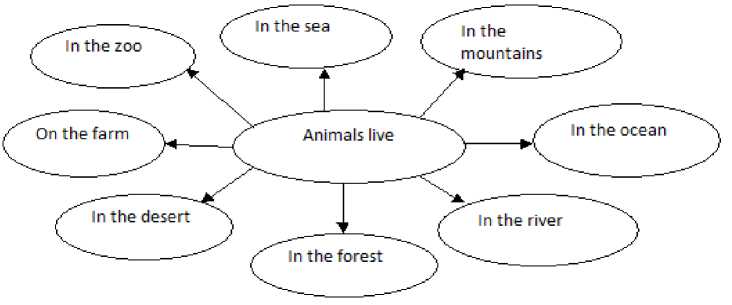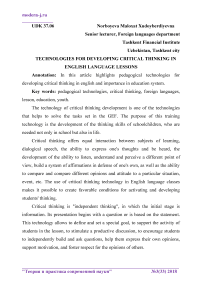Technologies for developing critical thinking in English language lessons
Автор: Norboyeva M.X.
Журнал: Теория и практика современной науки @modern-j
Рубрика: Основной раздел
Статья в выпуске: 3 (33), 2018 года.
Бесплатный доступ
In this article highlights pedagogical technologies for developing critical thinking in english and importance in education system.
Pedagogical technologies, critical thinking, foreign languages, lesson, education, youth
Короткий адрес: https://sciup.org/140272961
IDR: 140272961
Текст научной статьи Technologies for developing critical thinking in English language lessons
The technology of critical thinking development is one of the technologies that helps to solve the tasks set in the GEF. The purpose of this training technology is the development of the thinking skills of schoolchildren, who are needed not only in school but also in life.
Critical thinking offers equal interaction between subjects of learning, dialogical speech, the ability to express one's thoughts and be heard, the development of the ability to listen, understand and perceive a different point of view, build a system of affirmations in defense of one's own, as well as the ability to compare and compare different opinions and attitude to a particular situation, event, etc. The use of critical thinking technology in English language classes makes it possible to create favorable conditions for activating and developing students' thinking.
Critical thinking is "independent thinking", in which the initial stage is information. Its presentation begins with a question or is based on the statement. This technology allows to define and set a special goal, to support the activity of students in the lesson, to stimulate a productive discussion, to encourage students to independently build and ask questions, help them express their own opinions, support motivation, and foster respect for the opinions of others.
The structure of the lesson using the technology of development of critical thinking consists of 3 stages:
-
1) a call (the topic of the lesson is determined, the knowledge of the topic is updated)
-
2) comprehension (search for answers to questions that were raised in the beginning of the lesson)
-
3) reflection (there is a complete comprehension, generalization and assimilation of the information obtained).
These steps should be present in every lesson, as this gives the opportunity to fully observe a complex process that begins with the presentation of information, and ends with its comprehension, the adoption of decisions.
-
1 ) The Challenge. At this stage, the student "remembers" what he knows about this issue (predicts), systematizes information, asks questions for which he wants to receive an answer.
The role of the teacher at this stage is coordination. The essence of some tricks and strategies at this stage:
-
- Clusters - the selection of semantic units of text and their graphic design in a certain order in the form of a bunch. Clusters can become one of the main
techniques both at the stage of challenge or reflection, and the strategy of conducting the lesson as a whole.

Such chart charts can be used to visualize, structure and classify the material in the lesson, as an aid in learning, problem solving and decision making. They are helping:
It is easy to remember information;
facilitate visual perception and understanding of the issue; disclose information.
-
- Table of subtle and thick questions
This technique ("Thin and thick questions") can also be applied in any of the 3 stages of the lesson.
At the stage of the challenge - the prompting of interest in the study of the topic, at the stage of comprehension - as a way of actively posing questions during reading, listening, when reflecting, demonstration of the understanding of the studied.
|
Thick? |
Thin? |
|
Why do you think that…? |
Who…? |
|
Explain why…? |
Why…? |
|
What is the most important idea of the story? |
What…? When…? |
|
If you were… would you…? etc. |
Where…? Do you agree that…? |
-
- True / False- (approval, presentation of a picture, etc.)
-
2) Comprehension of content - the second stage of the lesson is aimed at: obtaining new information;
pupil's correction of the goal of training.
At this stage, you can use, for example:
-
• Reading text using the insert method.
This effective technique contributes to the development of critical thinking of students, with the help of which a wide range of lexical and grammatical assignments can be solved.
While reading the text, students in the fields make notes (with a pencil) or on a piece of paper.
"V" - already knew
«+» - new
"?" - do not understand etc.
After reading the text with the marking, students fill out the table
|
«√» Put "√" (yes) if you know or thought you knew |
«+» Put "+", if for you new what you read |
«-» Put "-" if what you read does not match your opinion |
"?" Put "?" If what you read is unclear |
• Highlight keywords (underline)
• Find answers to the questions posed at the beginning of the lesson.
-
3. Reflection is necessary not only for the teacher to check the memory of his students, but also for them to independently analyze what they could achieve their goal. This stage promotes the development of critical thinking skills.
Types of tasks:
-
1) Return to the keywords T or F (true-wrong)
-
2) Completion of the cluster of keywords
-
3) Answers to questions
-
4) Writing of creative works (essays, letters, work)
The considered methods of developing critical thinking in the English language classes provide an opportunity.
Список литературы Technologies for developing critical thinking in English language lessons
- Владимирова Л.П. Интернет на уроках иностранного языка. - ИЯШ. - №3. - 2002. - С 33-41.
- Фарходжонова Н. Ф. ПРОБЛЕМЫ ПРИМЕНЕНИЯ ИННОВАЦИОННЫХ ТЕХНОЛОГИЙ В ОБРАЗОВАТЕЛЬНОМ ПРОЦЕССЕ НА МЕЖДУНАРОДНОМ УРОВНЕ //Инновационные тенденции, социально-экономические и правовые проблемы взаимодействия в международном пространстве. - 2016. - С. 58-61.


